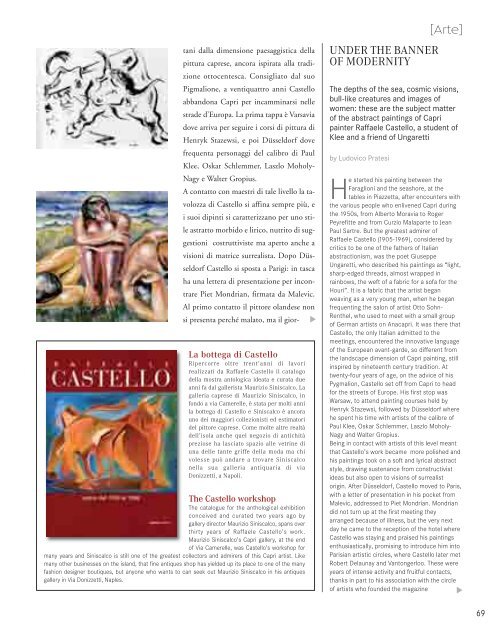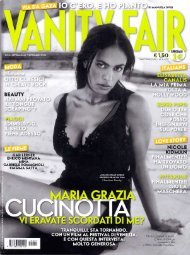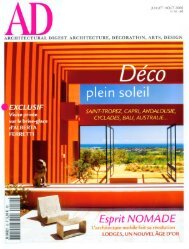Create successful ePaper yourself
Turn your PDF publications into a flip-book with our unique Google optimized e-Paper software.
tani dalla dimensione paesaggistica dellapittura caprese, ancora ispirata alla tradizioneottocentesca. Consigliato dal suoPigmalione, a ventiquattro anni Castelloabbandona Capri per incamminarsi nellestrade d’Europa. La prima tappa è Varsaviadove arriva per seguire i corsi di pittura diHenryk Stazewsi, e poi Düsseldorf dovefrequenta personaggi del calibro di PaulKlee, Oskar Schlemmer, Laszlo Moholy-Nagy e Walter Gropius.A contatto con maestri di tale livello la tavolozzadi Castello si affina sempre più, ei suoi dipinti si caratterizzano per uno stileastratto morbido e lirico, nutrito di suggestionicostruttiviste ma aperto anche avisioni di matrice surrealista. Dopo DüsseldorfCastello si sposta a Parigi: in tascaha una lettera di presentazione per incontrarePiet Mondrian, firmata da Malevic.Al primo contatto il pittore olandese nonsi presenta perché malato, ma il gior-La bottega di CastelloRipercorre oltre trent’anni di lavorirealizzati da Raffaele Castello il catalogodella mostra antologica ideata e curata dueanni fa dal gallerista Maurizio Siniscalco. Lagalleria caprese di Maurizio Siniscalco, infondo a via Camerelle, è stata per molti annila bottega di Castello e Siniscalco è ancorauno dei maggiori collezionisti ed estimatoridel pittore caprese. Come molte altre realtàdell’isola anche quel negozio di antichitàpreziose ha lasciato spazio alle vetrine diuna delle tante griffe della moda ma chivolesse può andare a trovare Siniscalconella sua galleria antiquaria di viaDonizzetti, a Napoli.The Castello workshopThe catalogue for the anthological exhibitionconceived and curated two years ago bygallery director Maurizio Siniscalco, spans overthirty years of Raffaele Castello’s work.Maurizio Siniscalco’s Capri gallery, at the endof Via Camerelle, was Castello’s workshop formany years and Siniscalco is still one of the greatest collectors and admirers of this Capri artist. Likemany other businesses on the island, that fine antiques shop has yielded up its place to one of the manyfashion designer boutiques, but anyone who wants to can seek out Maurizio Siniscalco in his antiquesgallery in Via Donizzetti, Naples.▼UNDER THE BANNEROF MODERNITYThe depths of the sea, cosmic visions,bull-like creatures and images ofwomen: these are the subject matterof the abstract paintings of Capripainter Raffaele Castello, a student ofKlee and a friend of Ungarettiby Ludovico Pratesi[Arte]He started his painting between theFaraglioni and the seashore, at thetables in Piazzetta, after encounters withthe various people who enlivened Capri duringthe 1950s, from Alberto Moravia to RogerPeyrefitte and from Curzio Malaparte to JeanPaul Sartre. But the greatest admirer ofRaffaele Castello (1905-1969), considered bycritics to be one of the fathers of Italianabstractionism, was the poet GiuseppeUngaretti, who described his paintings as “light,sharp-edged threads, almost wrapped inrainbows, the weft of a fabric for a sofa for theHouri”. It is a fabric that the artist beganweaving as a very young man, when he beganfrequenting the salon of artist Otto Sohn-Renthel, who used to meet with a small groupof German artists on Anacapri. It was there thatCastello, the only Italian admitted to themeetings, encountered the innovative languageof the European avant-garde, so different fromthe landscape dimension of Capri painting, stillinspired by nineteenth century tradition. Attwenty-four years of age, on the advice of hisPygmalion, Castello set off from Capri to headfor the streets of Europe. His first stop wasWarsaw, to attend painting courses held byHenryk Stazewsi, followed by Düsseldorf wherehe spent his time with artists of the calibre ofPaul Klee, Oskar Schlemmer, Laszlo Moholy-Nagy and Walter Gropius.Being in contact with artists of this level meantthat Castello’s work became more polished andhis paintings took on a soft and lyrical abstractstyle, drawing sustenance from constructivistideas but also open to visions of surrealistorigin. After Düsseldorf, Castello moved to Paris,with a letter of presentation in his pocket fromMalevic, addressed to Piet Mondrian. Mondriandid not turn up at the first meeting theyarranged because of illness, but the very nextday he came to the reception of the hotel whereCastello was staying and praised his paintingsenthusiastically, promising to introduce him intoParisian artistic circles, where Castello later metRobert Delaunay and Vantongerloo. These wereyears of intense activity and fruitful contacts,thanks in part to his association with the circleof artists who founded the magazine▼69






